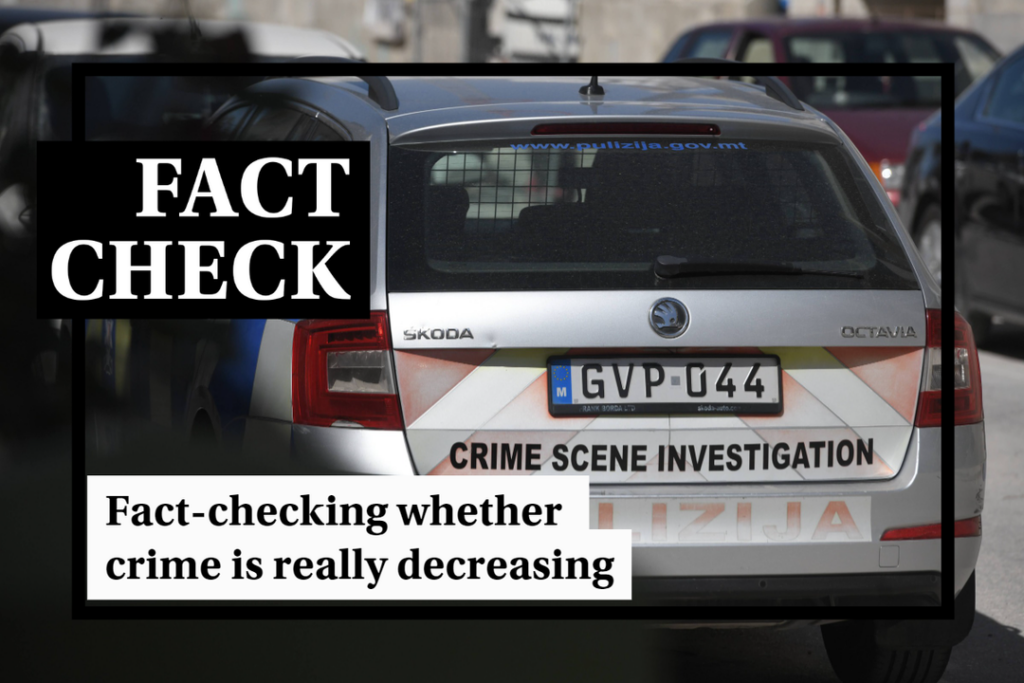A recent announcement that Malta’s crime rate has dropped to its lowest level since 2004 was met with surprise, with many arguing that this does not tally with their daily lived experience.
Some took to the media to pour scorn on the data, whilst MPs raised the issue in parliament, asking why record drug hauls are not yielding more court arraignments.
How are crime statistics gathered?
Official crime data is collected through the Annual Crime Review, a report published by the CrimeMalta Observatory, a body run by criminologist Saviour Formosa.
The report sources its statistics from the National Police System (NPS), a centralised database that records each crime report received by the police.
This is similar to the data collection methods used internationally, where local law enforcement agencies register crime reports within a centralised database that is then used to extract national data.
Malta’s crime statistics have been collected in the same way for several years.
Is the overall crime rate down?
Yes, data shows that Malta’s crime rate has dropped in recent years.
However, this data refers to reported crime and does not capture instances of crime that go unreported.
Just under 15,000 crimes were reported to the police in 2022, the lowest number since 2011, when 14,289 crimes were registered (excluding 2020, which was heavily impacted by the COVID-19 pandemic). 2005 was the single year with the highest number of crimes in the past two decades, with just over 18,500 crimes recorded.
Using the population data presented in the crime review shows that this amounts to some 28 crimes per 1,000 people in 2022, the lowest since data started being recorded in 2004, aside from 2020.
Examining the data against more accurate population data presented in the recent census reveals a similar trend, with the number of crimes per 1,000 people decreasing from just under 46 in 2005 to 34 in 2011 and finally just over 30 in 2021.
Does this mean that all crime is down?
No, different types of crimes have increased dramatically over the years, whilst others have experienced sharp decreases.
In general, violent crime – which includes crimes such as bodily harm, domestic violence and murder – has doubled, going from three to six crimes per 1,000 people between 2004 and 2022.
This is largely due to the increase in domestic violence, which has risen from merely 116 cases in 2007, when it first started being recorded, to 1,830 in 2022.
On the other hand, bodily harm has decreased slightly over the years, while the murder rate has remained broadly stable.
Likewise, white-collar crime such as fraud, money laundering and computer misuse has gone from under one crime per 1,000 people in 2004 to just under four last year.
The increase in fraud is particularly significant, growing from a total of 160 cases in 2004 to almost 2,400 in 2021, before shrinking to under 1,600 last year.
Drug-related crime, including possession, trafficking and importation has fluctuated from year to year, experiencing spikes in 2017, 2018 and, most significantly, 2021, when over 600 cases were reported. Last year’s rate is broadly in line with that recorded in several other years since 2007.
The overall decrease in crime rate is primarily driven by a decline in theft, which has dipped from over 11,000 in 2004 to just 4,500 in recent years.
Speaking to Times of Malta, Formosa attributed this gradual decline in theft to several factors, ranging from improved home security systems and CCTV coverage which reduces the opportunity for theft, to the disruption of international pick-pocketing rings which has seen reports of pick-pocketing plummet tenfold from almost 2,500 in 2016 to just 250 last year.
What do court records show?
Law enforcement authorities around the world sometimes also use court statistics to give a broader indication of the changes in crime from one year to the next.
Malta’s court records show that there were a total of 11,933 criminal arraignments last year, a figure almost identical to the 11,877 arraignments in 2021.
This would suggest that there are an average of just under 1,000 criminal arraignments each month, although these are not spread evenly throughout the year. In both 2021 and 2022, criminal arraignments dipped noticeably in the August, during which only around 500 arraignments were carried out in court.
Does the data show lower crime simply because fewer people are reporting crime?
Criminologist Sandra Scicluna suggests that this might be the case, citing several reasons why some may be reluctant to report a crime they have suffered, including the possibility of further victimisation, the belief that it’s not worth their while to report a crime and the fear of not being believed or having their plight minimised.
“We know that certain socio-economic groups are more reluctant to report. There could also be a cultural change happening. If foreigners do not feel understood by the police they are more likely not to report. We have seen this in some domestic violence cases where foreigners report.”
However, both local and EU data suggests that the public’s trust in the police is relatively high. A recent NSO survey found that over half of respondents held a positive opinion of the police, far outweighing the 9% who view the police force negatively.
Meanwhile, a 2023 Eurobarometer study found that 70% of Maltese tend to trust the police, a figure that is in line with the EU average.
Scicluna also points to a phenomenon called police discretion, where police at a busy station “might not be entering all the crimes as they need to decide where to dedicate their time”. According to Scicluna, police discretion “happens everywhere” and is particularly common when it comes to petty crime.
Could lower crime be linked to the decriminalisation of cannabis?
PN MP Joe Giglio touted this possibility in parliament, questioning whether authorities are “playing with the figures to fool people”.
The possession of small amounts of cannabis was decriminalised in December 2021, allowing anyone over the age of 18 to carry up to 7g of cannabis without risk of arrest or confiscation.
The data does show that there were fewer drug-related reports in 2022, particularly in terms of drug possession, which reached its lowest recorded level since 2007 following a spike in drug possession reports in 2021.
While data specific to cannabis possession for 2022 is not yet available, Malta’s National Drug Report shows that there were 82 arraignments for cannabis possession in 2021 and a further 87 in 2020. This would suggest that even if 2022 saw fewer cannabis arraignments than previous years, this alone would not explain the decrease in drug-related crime or other related crime such as theft.
Scicluna dismissed the suggestion that cannabis decriminalisation could have a significant impact on Malta’s crime rate, arguing that “marijuana is a rather cheap drug so we would not have seen a decrease in theft or fraud because of marijuana legalisation”.
Formosa warned that it is too early to determine the impact of cannabis decriminalisation on crime statistics. Drawing a parallel with instances where legal amendments resulted in initially inconsistent data, Formosa said “before stating that the numbers decreased because of lesser enforcement based on legal changes I would wait for the next two years and watch those trends”.
Why do people feel less safe?
According to Scicluna, “people perceive crime according to their feelings, according to what they hear, according to what is reported in the media”. This could suggest that the perception of widespread crime is partly fuelled by more comprehensive news coverage of crime and criminal proceedings.
“The more violent crime reported the less safe people feel. We know that all homicides and almost all serious bodily harm is reported. But we know that rape is often not reported. So the perception of the people is based on what they hear. The closer to home the crime reported the more people panic and feel unsafe”.
Formosa echoed this, warning against a “moral panic” based upon individual crimes that, although shocking, may not be representative of a wider trend.
“Crime changes as society morphs. Offenders seek new opportunities to commit crime, especially more serious crimes. As society changes there will be new opportunities for crime that the police need to be prepared for,” he said.
‘The dark figure of crime’
Scicluna argued that while official crime statistics are crucial in understanding the state of criminal activity within the country, there is also a need to measure the degree of unreported crimes, known as the “dark figure of crime”, through a Crime Victimisation Survey.
“These surveys shed light on what is not being reported by comparing them with what is reported,” she said.
The Times of Malta fact-checking service forms part of the Mediterranean Digital Media Observatory (MedDMO) and the European Digital Media Observatory (EDMO), an independent observatory with hubs across all 27 EU member states that is funded by the EU’s Digital Europe programme. Fact-checks are based on our code of principles.
Let us know what you would like us to fact-check, understand our ratings system or see our answers to Frequently Asked Questions about the service.





